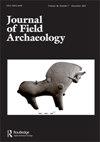The Role of the Field Architect in the Digital Age: Integrating Human and Electronic Recording at the Villa Arianna in Roman Stabiae
IF 1.5
1区 历史学
0 ARCHAEOLOGY
引用次数: 0
Abstract
ABSTRACTDigital recording technologies such as lidar and photogrammetry bring higher efficiency to archaeological recording, as well as the allure of automation. How do the promises of the digital age impact the role and methods of field architects, members of an archaeological team responsible for illustrating architectural finds? Between 2011 and 2022, University of Maryland field architects grappled with this question while recording the frescoed rooms of the Villa Arianna in Roman Stabiae. Like other Roman houses preserved by the eruption of Vesuvius in a.d. 79, the villa contains many building phases, destruction deposits, and large spaces adorned with detailed frescoes. To accurately capture this diversity, the field team integrated several digital-assisted recording techniques with traditional manual approaches. While electronic technologies aided the architects in measuring the villa at multiple scales, we found that they could not replace the field architect’s capacity for granular first-hand observation, historical learning, and interpretation of archaeological signatures.KEYWORDS: Field architectdigitalarchaeological illustrationfrescoStabiaeVilla AriannaRoman Geolocation InformationThe plan (see Figure 2) showing the Villa Arianna in Castellammare di Stabia, Italy, uses geo-referenced benchmarks from Vittorio Fontanella’s survey between April and June 2010, with elevation levels obtained by Thomas Howe in June 2010. BM 4–6 are the benchmarks used for the “First Complex” of the Villa Arianna, the focus of this study. The benchmarks are registered to the following Gauss-Boaga national grid coordinates: BM 4: X Easting 2477059.9339, Y Northing 4505546.6179, Z Elevation masl 48.501; BM 5: X Easting 2477080.5349, Y Northing 4505554.8649, Z Elevation masl 49.616; BM 6: X Easting 2477122.8300, Y Northing 4505589.8595, Z Elevation masl 49.692.AcknowledgmentsThis research has been generously funded by the Wilhelmina F. Jashemski and Stanley A. Jashemski Research Grant Program and was carried out with the support of the Restoring Ancient Stabiae Foundation and the Soprintendenza Speciale per i Beni Archeologici di Pompei, Ercolano e Stabia. A great debt of gratitude is due to Robert Lindley Vann, originally the PI of the archaeological work-study program at the Villa Arianna in Stabiae. Thanks are also due to the many UMD students and alumni who made the architectural drawings and to the staff of the Vesuvian Inn.Additional informationNotes on contributorsJoseph C. WilliamsJoseph C. Williams (Ph.D. 2017, Duke University) is an architectural historian and Assistant Professor of Architecture at the University of Maryland. His research uncovers the nature of builders’ knowledge before modernity, with a focus on ancient and medieval southern Italy and its Mediterranean orbit. In particular, he applies the methods of building archaeology to examine construction techniques and their role in premodern design process. Williams developed these methods during his Ph.D. in architectural history at Duke, as well as a Kress fellowship at the American Academy in Rome, resulting in his 2020 book Architecture of Disjuncture, which focused on cathedral building in medieval Apulia. He has also directed the UMD archaeological work-study program at the Villa Arianna in Roman Stabiae, documented Byzantine-Norman churches in Sicily with the support of a Dumbarton Oaks Project Grant, and founded the new MAPP Architectural Representation Lab (MARL) at UMD.Thomas HoweThomas Noble Howe (Ph.D. 1985, Harvard University), is an architect, archaeologist, architectural historian, and Professor of Architecture at Southwestern University. He holds a Master of Architecture from the Harvard Graduate School of Design, as well as a Ph.D. in Fine Arts from Harvard, where he focused on Greek and Roman Architecture. Howe has 40 years’ experience in field archaeology and is currently Director of Excavations of the Villa Arianna in Roman Stabiae. His publications include numerous archaeological studies of ancient buildings, such as the 1977 book The Romano-British Villa at Castle Copse, Great Bedwyn, with E. Hostetter, as well as the 2014 translation of Vitruvius’s Ten Books of Architecture, with Ingrid D. Rowland. Howe takes a particular interest in methods of architectural recording at archaeological sites and how precision-recording is necessary for a full appreciation of ancient design practice.Adan RamosAdan Ramos (M.Arch 2019, University of Maryland) is currently a Lecturer teaching design studio. He has served as a Research and Teaching Assistant for the UMD archaeological work-study program at the Villa Arianna in Roman Stabiae and co-organized the comprehensive survey of the frescoed walls of the “first complex.” Ramos is interested in the critical use of digital technologies for architectural survey.Gabriel MaslenGabriel Maslen (B.S.Arch 2015, University of Maryland) studies Architecture and Urban Design at the Politecnico di Milan. He has served as a Research and Teaching Assistant for the UMD archaeological work-study program at the Villa Arianna in Roman Stabiae and co-organized the comprehensive survey of the frescoed walls of the “first complex.” He takes a special interest in methods of architectural draftsmanship and the pedagogy thereof.数字时代现场建筑师的角色:在罗马斯塔比亚的阿里安娜别墅整合人类和电子记录
【摘要】激光雷达、摄影测量等数字记录技术为考古记录带来了更高的效率,同时也带来了自动化的魅力。数字时代的承诺如何影响现场建筑师的角色和方法,考古团队的成员负责说明建筑发现?在2011年至2022年之间,马里兰大学的建筑师在记录罗马斯塔比亚的阿里安娜别墅的壁画房间时,努力解决了这个问题。像公元79年维苏威火山爆发保存下来的其他罗马房屋一样,这座别墅包含了许多建筑阶段,破坏沉积物和装饰有详细壁画的大空间。为了准确地捕捉这种多样性,现场团队将几种数字辅助记录技术与传统的手动方法相结合。虽然电子技术帮助建筑师在多个尺度上测量别墅,但我们发现它们无法取代现场建筑师的第一手观察、历史学习和考古特征解释的能力。该平面图(见图2)展示了意大利斯塔比亚城堡的阿里安娜别墅,使用了2010年4月至6月Vittorio Fontanella调查的地理参考基准,海拔高度由Thomas Howe在2010年6月获得。BM 4-6是Arianna别墅“第一综合体”的基准,也是本研究的重点。基准注册到以下gaas - boaga国家网格坐标:bm4: X east 2477059.9339, Y north 4505546.6179, Z Elevation masl 48.501;bm5: X东2477080.5349,Y北4505554.8649,Z高程49.616;bm6: X东2477122.8300,Y北4505589.8595,Z高程49.692。本研究得到了Wilhelmina F. Jashemski和Stanley A. Jashemski研究资助计划的慷慨资助,并得到了修复古马塔基金会和庞贝考古博物馆(Soprintendenza Speciale per i Beni Archeologici di Pompei, Ercolano e Stabia)的支持。罗伯特·林德利·范恩(Robert Lindley Vann)非常感激,他最初是斯塔比埃别墅阿里安娜(Villa Arianna)考古勤工俭学项目的负责人。还要感谢许多马里兰大学的学生和校友,他们绘制了建筑图纸,也感谢维苏威酒店的工作人员。joseph C. Williams(杜克大学2017年博士)是马里兰大学建筑历史学家和建筑助理教授。他的研究揭示了现代之前建筑商知识的本质,重点关注古代和中世纪的意大利南部及其地中海轨道。特别是,他运用建筑考古学的方法来检验建筑技术及其在前现代设计过程中的作用。威廉姆斯在杜克大学建筑史博士学位期间开发了这些方法,并在罗马美国学院获得了克雷斯奖学金,并于2020年出版了《脱节的建筑》一书,该书专注于中世纪普利亚的大教堂建筑。他还指导了UMD在Roman Stabiae的Villa Arianna的考古勤工俭学项目,在敦巴顿橡树项目拨款的支持下记录了西西里岛的拜占庭诺曼教堂,并在UMD建立了新的MAPP建筑表现实验室(MARL)。Thomas Noble Howe(1985年毕业于哈佛大学),是一位建筑师、考古学家、建筑历史学家和西南大学建筑学教授。他拥有哈佛大学设计研究生院的建筑硕士学位,以及哈佛大学美术博士学位,在那里他专注于希腊和罗马建筑。Howe在野外考古方面有40年的经验,目前是罗马斯塔比亚的阿里安娜别墅发掘主任。他的出版物包括许多关于古代建筑的考古研究,如1977年与E. Hostetter合著的《大贝德温城堡的罗马-英国别墅》,以及2014年与Ingrid D. Rowland合著的《维特鲁威的建筑十书》。Howe特别感兴趣的是考古遗址的建筑记录方法,以及精确记录对于充分欣赏古代设计实践的必要性。Adan Ramos(硕士,2019年,马里兰大学)目前是一名设计工作室的讲师。他曾在罗马斯塔比亚的Villa Arianna担任UMD考古勤工助学计划的研究和助教,并共同组织了对“第一建筑群”壁画墙的全面调查。Ramos对数字技术在建筑勘测中的关键应用很感兴趣。Gabriel MaslenGabriel Maslen(马里兰大学建筑学学士,2015年毕业)在米兰理工大学学习建筑与城市设计。 他曾在罗马斯塔比亚的Villa Arianna担任UMD考古勤工助学计划的研究和助教,并共同组织了对“第一建筑群”壁画墙的全面调查。他对建筑制图方法及其教学法特别感兴趣。
本文章由计算机程序翻译,如有差异,请以英文原文为准。
求助全文
约1分钟内获得全文
求助全文
来源期刊

JOURNAL OF FIELD ARCHAEOLOGY
ARCHAEOLOGY-
CiteScore
4.60
自引率
5.30%
发文量
29
期刊介绍:
The Journal of Field Archaeology is an international, refereed journal serving the interests of archaeologists, anthropologists, historians, scientists, and others concerned with the recovery and interpretation of archaeological data. Its scope is worldwide and is not confined to any particular time period. Contributions in English are welcomed from all countries.
 求助内容:
求助内容: 应助结果提醒方式:
应助结果提醒方式:


